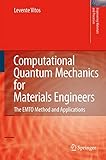Computational Quantum Mechanics for Materials Engineers [electronic resource] : The EMTO Method and Applications / by Levente Vitos.
Series: Engineering Materials and ProcessesPublisher: London : Springer London, 2007Description: XII, 237 p. 92 illus. online resourceContent type:- text
- computer
- online resource
- 9781846289514
- 620.11 23
- TA404.6
 eBooks
eBooks
The Method -- Basics of Electronic Structure Calculations -- Exact Muffin-tin Orbitals Method -- Slope Matrix -- Full Charge Density Technique -- The EMTO-CPA Method -- Applications -- Ground-state Properties -- Ordered Solids -- Binary Alloys -- Iron—chromium—nickel Alloys.
Traditionally, new materials have been developed by empirically correlating their chemical composition, and the manufacturing processes used to form them, with their properties. Until recently, metallurgists have not used quantum theory for practical purposes. However, the development of modern density functional methods means that today, computational quantum mechanics can help engineers to identify and develop novel materials. Computational Quantum Mechanics for Materials Engineers describes new approaches to the modelling of disordered alloys that combine the most efficient quantum-level theories of random alloys with the most sophisticated numerical techniques to establish a theoretical insight into the electronic structure of complex materials such as stainless steels, Hume-Rothery alloys and silicates. The practical success of these approaches to applications in all of these areas are covered in detail. The new EMTO-CPA method is detailed, including its application in alloys to model structural stability and elastic properties of random alloys of arbitrary composition and the effect of alloying elements on elastic stiffnesses stacking fault energies and structural parameters. The EMTO-CPA method makes new approaches to computational alloy design feasible. Computational Quantum Mechanics for Materials Engineers shows how the technique will soon allow materials engineers to become "quantum blacksmiths". Computational Quantum Mechanics for Materials Engineers will interest researchers and postgraduate students in materials science and engineering, solid-state physics and applied quantum mechanics.


